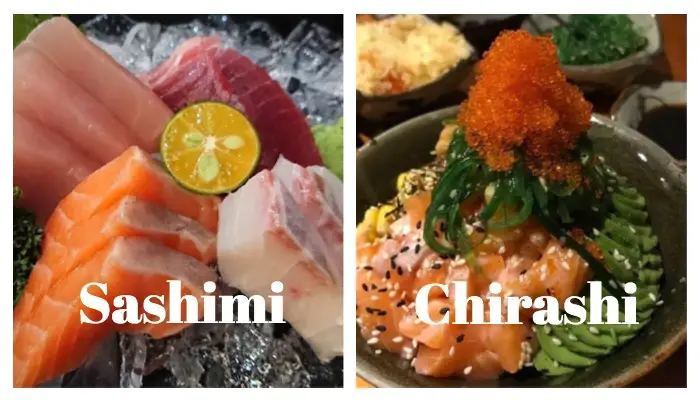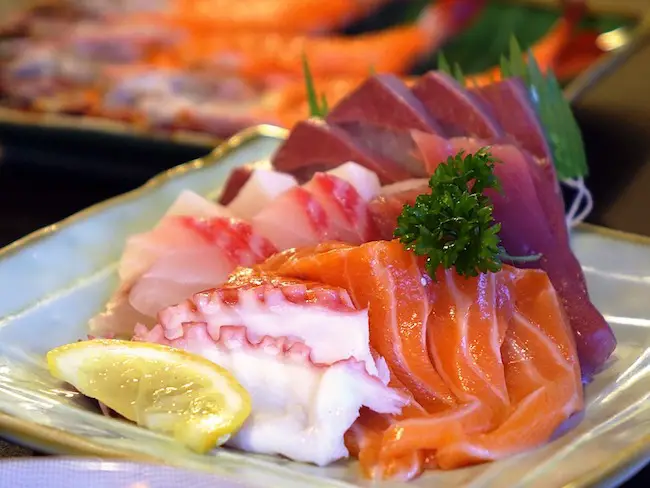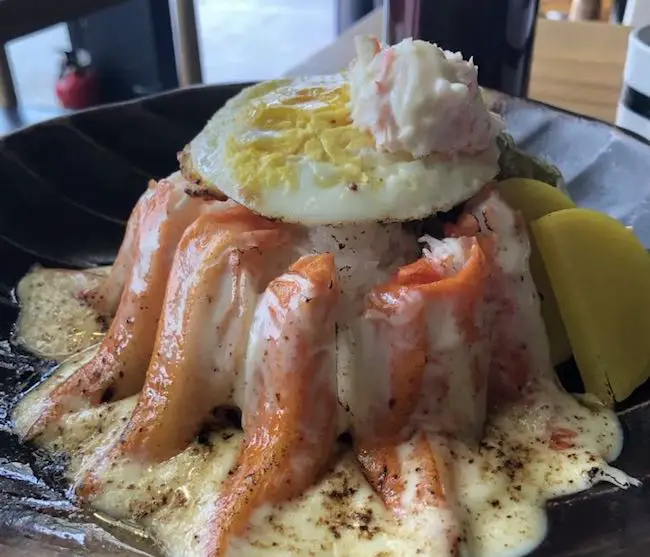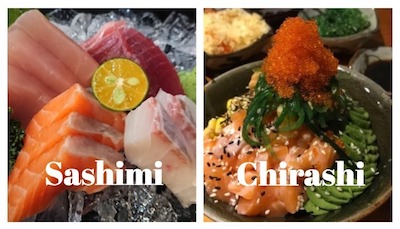We are reader supported. When you purchase through links on our site, we may earn an affiliate commission. Also, as an Amazon affiliate, we earn from qualifying purchases.

If you enjoy trying new foods and dishes it really does help to understand what you are ordering and eating. If you don’t speak Japanese you might not understand the meaning of Chirashi or Sashimi. This is a great place to start!
‘What are the differences between Chirashi & Sashimi?’ In the Japanese language Chirashi means “scattered” and Sashimi means “pierced or cut body”. Chirashi is a bowl of mixed ingredients whereas Sashimi is raw sliced fish and or meat.
Now that I have your attention, let’s dive right into both Chirashi and Sashimi to see what the differences really are and what you can expect to find the next time you visit your favorite Japanese restaurant. Understanding the difference between the two will help you better choose the dish you are in the mood for. Also, there will be no surprises when the plate arrives!
Contents
The Origin of Chirashi
It is believed that Chirashi was created because chefs didn’t want to waste pre-cut pieces of raw fish and other ingredients when making Sashimi (which we will discuss below) and Nigiri (for more info). It was a clever way to make use of perfectly good food that would otherwise be thrown out.
What is a Chirashi [Bowl or Chirashi Sushi?]
If you are in the mood for sushi, but not quite skilled in sushi rolling, this is what you want. Chirashi bowl is a bowl filled with rice and raw fish, vegetables and other ingredients mixed in. The variations depend on which bowl you select. Chirashi can also be served as a vegetarian dish by simply omitting the meats and fish.
If the ingredients in this bowl sound familiar, you are on the right track. This dish is basically sushi without being rolled, however, Chirashi has more rice vinegar than traditional sushi. White rice is most commonly used yet you could eat this dish with brown or wild rice for added flavor, fiber, and nutrients.
The bowl comes with rice, lining the bottom, and the remaining ingredients on top. There is a wide variety of topping choices, depending on your personal preference. So many combinations work well with this dish.
Chirashi bowls are commonly found with some (or more) of the following ingredients.
- Raw fish such as tuna, conch or salmon. You could also use shrimp or octopus, however, these ingredients won’t be raw like the previously mentioned fish.
- Sliced Eggs
- Fish roe
- Shiitake mushrooms
- Lotus root
- Scallion
- Bamboo shoots
- Bean sprouts
- Cucumber
- Sautéed onion
- Cooked spinach
As you can see, you are only limited to your imagination when making this dish. If you are in a restaurant then, of course, you are limited to what the restaurant is offering to serve on their Chirashi. Interestingly, if you are having Chirashi in Japan, you will find that toppings on this dish differ depending on what region you are in.
How to eat Chirashi
Like most other Japanese foods, the best way to enjoy this meal is with chopsticks. A great tip for you if you are new to eating Japanese food is to “not” pour soy sauce over your rice and other ingredients. The reason you don’t do this is because the food (especially the rice) will be very hard to pick up with chopsticks afterward. The great thing about sticky rice is it ‘sticks together’ making it easy to eat. This also allows you to pick up a larger portion with your chopsticks.
The best thing to do is have a small bowl with soy sauce beside your plate and dip the ingredients into it (if you want to have soy on your food). After having a mouthful of the soy-dipped food then it is time to grab some rice. This makes it much easier to eat!
What is Bara Chirashi
Bara Chirashi is a good choice for if you do not enjoy raw fish. The Bara version of this dish has the fish and other ingredients cooked. Because of this, it is a safer and healthier option.
How does Chirashi compare to Sashimi? Let’s have a look.
The origin of Sashimi
It is not exactly clear as to when Sashimi first came to be, however, it is rumored to have been created back in the Heian and Kamakura periods. Because of the abundance of fish, it was created (and only available) in Japanese coastal regions. This is most likely due to the difficulty of keeping raw fish fresh during transport.
What is Sashimi

Sashimi is raw seafood that is sliced into edible pieces so it can go from your plate to the soy sauce bowl, to your mouth with ease! Wasabi is also included in this dish. Some other ingredients may be present but it will consist primarily of raw fish. If you are on a low carbohydrate diet, this is a terrific meal for you!
The thickness of the fish pieces can definitely differ depending on where you get your Sashimi from. However, the most popular style is a very thinly sliced cut which is called Tsukuri. If you want it cut even thinner (so you can almost see right through the fish), you will want to order Usuzukuri.
If you just can’t get yourself to eat the fish raw then you can order it slightly cooked. When Sashimi is served like this it is named Tataki.
The fish you would find on a Sashimi plate is the same as that in a Chirashi bowl. There are so many options for raw fish you can choose from including:
- Tuna
- Salmon
- Flounder
- Ahi
- Squid
- Scallops
- Clam
- Shrimp
- Octopus
- Crab
And the list goes on…these are just some of your options for Sashimi.
Want to eat your fish while it is still alive? If you have living fish on your Sashimi plate it is called Ikizukuri. This is controversial in nature as some people deem it inhumane to eat live creatures.
How to eat Sashimi
Sashimi should be eaten in the traditional way by using chopsticks. Take a piece of raw (or living) fish and dip it into a bowl of soy sauce. Eating the fish with wasabi will help draw out the flavor of the meal while suppressing bacteria that can cause food poisoning. Sometimes white radishes (along with perilla) are served with Sashimi.
Wasabi, white radishes and perilla (an Asian plant of the mint family) will all help to enhance the flavor of your meal as well as keep the fishy smell and taste to a minimum.
Interestingly, when Sashimi is served, there are almost always delicately carved vegetables alongside the meal. Japanese-style chefs are very proud of their culinary skills and will showcase them when creating this dish. This all adds to the enjoyment of the meal.
What are the differences between Chirashi and Sashimi
It should be quite clear by now that a Sashimi dish is primarily fish or, in some cases, meat. It is prepared by slicing everything in bite-sized pieces, depending on which dish you select. Sashimi can be served with varying thicknesses of meat, ranging from extremely thin to regular thickness. It is eaten with soy sauce and wasabi.
A note of caution for anyone who is pregnant. Make sure when eating Sashimi that you have selected cuts of fish that are typically not high in mercury as this can cause health issues for your unborn baby. These are usually larger fish that feed on smaller fish including tuna, swordfish and sea bass, just to name a few.

A Chirashi bowl will have the fish or meat from Sashimi on top of a bed of sticky rice. There will also be some sliced vegetables and maybe some eggs. The fish and meat can sometimes be cooked.
If your goal is to eat low carbohydrate foods, then Sashimi is the way to go. If you are looking for a balance of nutrients from the different food groups, then Chirashi is the meal for you.
Related Question
How much Chirashi or Sashimi is too much?
Personally, I would like to think that I could eat these foods every day, three times a day! However, as with any food choice, moderation is the key. These foods are rich in nutrients, flavor, and texture. So go ahead, enjoy and indulge yourself!

